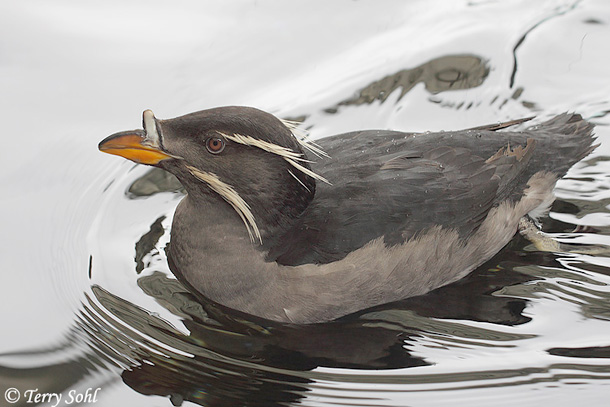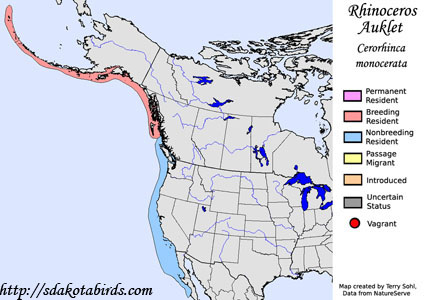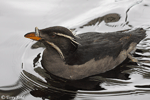| Length: 15 inches | Wingspan: 22 inches | Seasonality: Non-resident in South Dakota |
| ID Keys: Dark gray upperparts, lighter gray underparts. In breeding, orange bill with fleshy protuberance, and 2 white plumage stripes | ||
 The
Rhinoceros Auklet is a large seabird, closely related to puffins. They
are named for the fleshy protuberance that grows on their upper mandible
each spring before the breeding season. The 'horn' is lost each fall,
only to regrow the following spring. Outside of the breeding season,
they are sometimes confused with the Tufted
Puffin, but the bill of a Rhinoceros Auklet is much less massive than a
puffin's bill at all seasons. Populations on some former breeding
colonies crashed after the accidental introduction of rodents. Active
efforts to remove all rats and rabbits from some islands have led to
successful recolonization of former nesting colonies.
The
Rhinoceros Auklet is a large seabird, closely related to puffins. They
are named for the fleshy protuberance that grows on their upper mandible
each spring before the breeding season. The 'horn' is lost each fall,
only to regrow the following spring. Outside of the breeding season,
they are sometimes confused with the Tufted
Puffin, but the bill of a Rhinoceros Auklet is much less massive than a
puffin's bill at all seasons. Populations on some former breeding
colonies crashed after the accidental introduction of rodents. Active
efforts to remove all rats and rabbits from some islands have led to
successful recolonization of former nesting colonies.
Habitat: During the summer breeding season, found on islands with suitable soil for digging nesting burrows. At other seasons, tends to forage out at sea where upwelling currents concentrate fish and other prey, but moves closer to shore to overnight in and around protected coastal waters.
Diet: Feeds on fish and crustaceans such as shrimp and amphipods..
Behavior: Feeds by diving and swimming underwater.
Nesting: The nest of a Rhinoceros Auklet is a burrow, built in grassy areas with scattered rocks or trees. The burrow may be up to 20 feet long, ending in a nesting chamber with a nest built of mosses, seaweed and twigs. The female lays one egg per season. Both the parents help to incubate the egg, and both parents help feed the young upon hatching.
Song: On breeding colonies, low moaning calls and shorter barking calls are heard. Outside of the breeding season, they are mostly silent.
Migration: While some auks in the north Pacific are relatively permanent residents, the Rhinoceros Auk is strongly migratory. Most birds leave the northern part of their range in the fall and move southward along the Pacific Coast.
Interactive eBird Map: Click here to access an interactive eBird map of Rhinoceros Auklet sightings
Similar Species: Generally unmistakable if seen well, but possibly confused with Tufted Puffin and Horned Puffin species in non-breeding plumage.
Conservation Status: Populations are undoubtedly lower now than prior to colonization of North America, and there are indications that populations have continued to decline in recent decades. However, they are still widespread and relatively common in many areas. The IUCN lists the Rhinoceros Auklet as a species of "Least Concern".
Further Information: 1) Alaska SeaLife Center - Rhinoceros Auklet
2) BirdWeb.org - Rhinoceros Auklet
3) Alaska Seabird Information Series - Rhinoceros Auklet
Photo Information: Photo taken in June 2008 - Alaska SeaLife Center in Seward, Alaska - Terry Sohl
| Click below for a higher-resolution map |
 |
| South Dakota Status: Non-resident in South Dakota |
Additional Rhinoceros Auklet Photos
Click for a higher-resolution version of these photos

